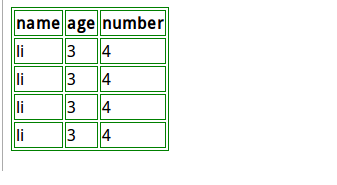CSS table
In the study of tables, we mainly understand the following attributes:
border-collapse ---Set whether to merge the table borders into a single border.
border-spacing ---Set the distance separating cell borders.
caption-side --- Set the position of the table title.
empty-cells ---Set whether to display empty cells in the table.
table-layout ---Set the algorithm for displaying cells, rows and columns.
Here we only use the most commonly used attributes, and we will do experiments while talking. First, we first create a table and add the following content:
<table id="tb"> <tr> <th>name</th> <th>age</th> <th>number</th> </tr> <tr> <td>li</td> <td>3</td> <td>4</td> </tr> <tr class="tr2"> <td>li</td> <td>3</td> <td>4</td> </tr> <tr> <td>li</td> <td>3</td> <td>4</td> </tr> <tr class="tr2"> <td>li</td> <td>3</td> <td>4</td> </tr> </table>
Of course this is the effect of no borders. , below we will add a border and specify the color (outer border and inner border) in CSS:
#tb,tr,th,td{
border: 1px solid green;
}As you can see, the effect is as follows:

These are the default attributes. Next we will customize the list through CSS. First, we first use border-collapse to merge the entire list border into a single line, then use width and height to customize the table size, then use background-color to add the background color, text-align to set the character alignment, and padding to set the inner border. :
#tb td,th{
border: 1px solid green;
padding: 5px;
}
#tb{
border-collapse: collapse;
width: 500px;
text-align: center;
}
#tb th{
text-align: center;
color: black;
background-color: lightseagreen;
}
#tb tr.tr2 td{
color: black;
background-color: #B2FF99;
}The effect is as follows:

